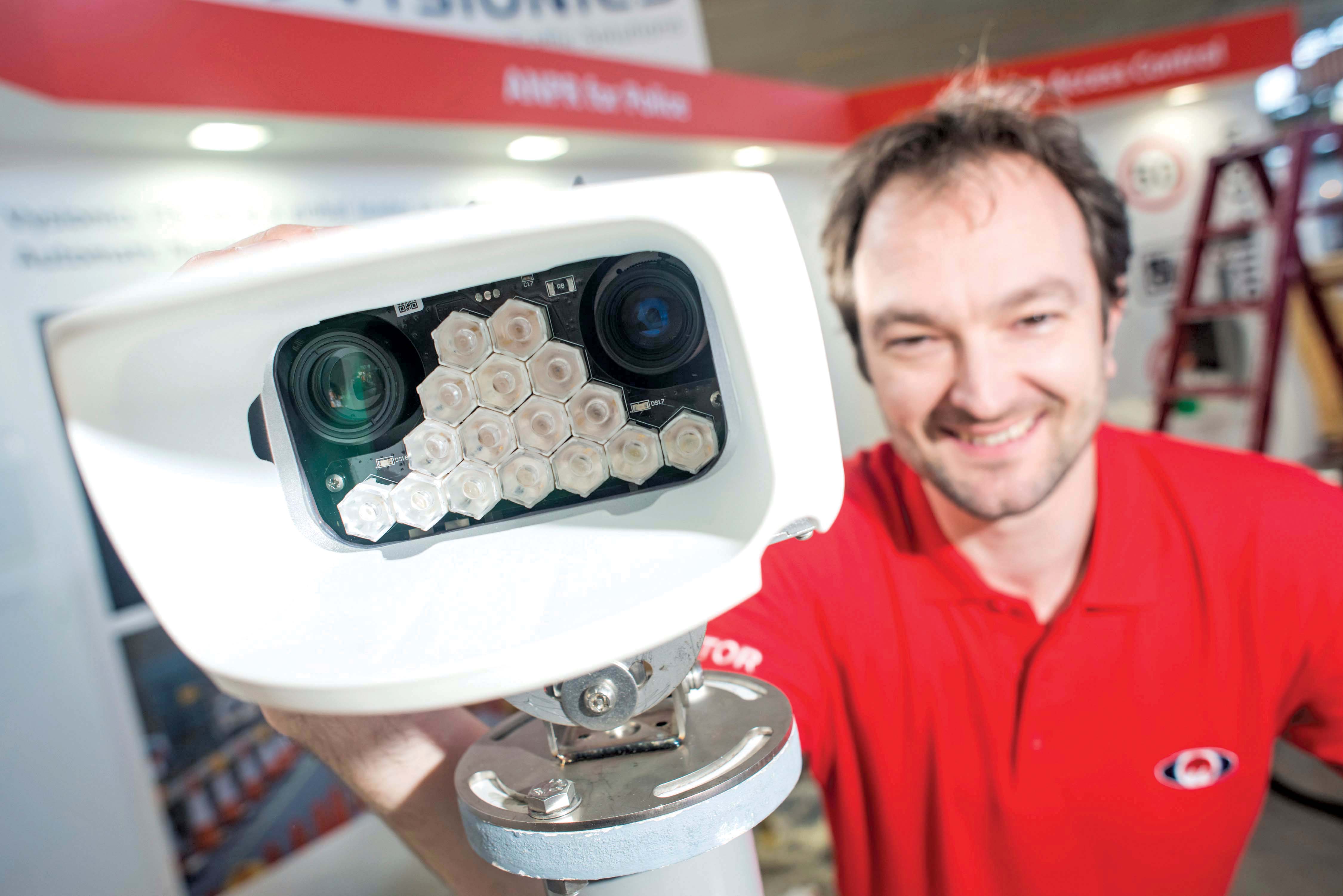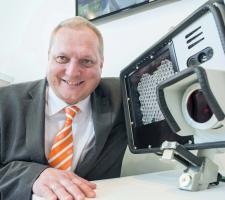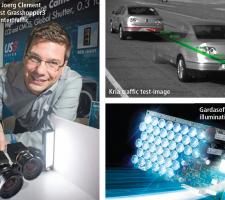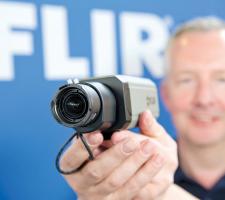
In the industrial world machine vision is helping to monitor and control almost everything from steel mills to microprocessor production - the applications of machine vision are almost unbounded. However, the ever-changing nature of traffic, variable ambient conditions, widely differing requirements and often mutually exclusive regulations, make the integration of machine vision into the ITS sector far more challenging.
In essence machine vision entails the use of intelligent image processing and placing that processing capability inside or near to the camera itself rather than at some form of control centre. The benefits are easy to encapsulate: reduced bandwidth requirement as live video does not have to be streamed back to the control room; and image processing and interpretation means control room staff are alerted to occurrences requiring immediate attention.
“In the early days there were often computers tethered to the bottom of the pole on the side of the road but these were too easily stolen, so the processor was moved to inside the housing which exacerbated heat build-up problems,” says Jochen Braun, sales director at machine vision specialists
These paroblems are being overcome and his company’s latest
Others are working on this problem too and the latest version of
Already multifacetted and now freed from the need for hard-wired power and to stream everything back to servers at the traffic control centre, the application of machine vision techniques to ITS applications is becoming increasingly widespread. This was evident at the recent Intertraffic exhibition and AIA Vision Show.
While it is possible to graft a degree of machine vision into analogue cameras, the possibilities are far greater with digital images. The battle between the lower cost CMOS sensors and the higher priced/higher quality CCD continues although the consensus is that the quality gap between the technologies is narrowing.
Joerg Clement, EMEA manager for Point Grey says: “It’s an exciting development which brings an order-of-magnitude improvement to applications such as those in the transport sector.”
Across at the ALA Vision Show
Late last year
The trend towards higher resolution sensors not only improves image sharpness, it also enables the live image to be subdivided into multiple areas of interest and the application of machine vision allows each area to be analysed differently. So at a junction with two lanes of traffic travelling in each direction; not only can each number plate be automatically located and identified, the complete contextual image can be simultaneously captured.
A prime example is
Also displayed at Intertraffic was Tattile’s Vega Colour camera with embedded optical character recognition that not only recognises the number plate but also the colour of the plate which can be useful in identifying the vehicle’s country/state of origin. Likewise
The colour/monochrome requirement is highly important as the need for colour contextual images precludes the use of infrared flash in low light conditions. And as numberplates are usually made from highly reflective material, this poses problems for analogue cameras – especially at night because the brightness range between the flash-illuminated scene and the reflective number plate is too high to capture in one image. With machine vision systems the electronics can identify the licence plate area and process the data from that section of the sensor accordingly in order that one image contains both the contextual view and the numberplate.
A combination of laser-based 3D modelling and infrared imaging is at the heart of
The 3D ‘stereo’ vision approach is central to
The new XCamEdge automatic incident detection system from
In a similar vein
Not only do machine vision techniques within TrafiBot HD reduce the network traffic, the company says that in periods when the camera is not detecting an incident, it generates zero network traffic.
Such is the improvement in definition and the processing capabilities of machine vision that where once four or even eight cameras were needed to cover an intersection, this can now be done with one or two – which does much to offset price premium and boost availability as well as drastically reducing the bandwidth requirement.
One example is
Speaking at Intertraffic, CA Traffic’s managing director Bernard Greene said the version of the EVO-X camera on show was “the First of several variants”.
Developing yet another machine vision application is
The latest high definition automatic numberplate recognition system from
Meanwhile
On the tolling side
“Thanks to positive references, the automatic label checking system is being requested beyond the country’s frontiers. We know several European states are considering the deployment of an automatic enforcement system and are impressed by the high enforcement rates,” says Efkon’s sales director Bernhard Czar.
Transport for London and
Ever tighter privacy and data protection requirements may lead to an increased reliance on machine vision techniques to include or exclude parts of an image and to prevent any information regarding non-offending vehicles even entering the authority’s system. For its part
While the image does capture the numberplate, in the First instance the system uses other factors to identify the vehicle and therefore avoids many of the privacy and data protection pitfalls. “It is like face recognition for the back of the vehicle; there’s a sticker HERE, a dent there and a scratch somewhere else – they are all indicators,” says Xerox’s Richard Harris.
Such technology may also find a use in countries where ANPR may be difficult for other more prosaic reasons such as a high proportion of non-domestic vehicles or a variety of fonts. “In some countries it is even possible for more than one vehicle to be allocated the same registration but just a different colour,” he says. In such cases enforcement could be particularly difficult and especially during the hours of darkness. “Our system can distinguish between two vehicles fitted with the same registration number – even at night,” says Harris.
Privacy and data protection
The ever-expanding capabilities of machine vision have taken privacy and data protection considerations into uncharted territory, keeping lawmakers around the world very busy. In Europe the EU is to adopt a new cyber-security framework and data protection rules by 2015. According to data protection law expert Kathryn Wynn of Pinsent Masons, the rules will not outlaw particular functions but will make it more difficult to get approval for technology that can track, trace or identify individuals.
“If an authority can show there is a speeding problem, it will still be allowed to install speed cameras, although the justifications requirements may be higher in 2015 particularly with the proposed introduction of mandatory Privacy Impact Assessments,” she says.
However, the Advent of machine vision makes the situation both simpler and more difficult at the same time. On the positive side the machine vision cameras at a junction may transmit only the details of offending vehicles while overwriting and obliterating details relating to all non-offenders. But if that junction is adjacent to a pub or bar and the camera has a surveillance function, that ability could capture the comings and goings of those entering and leaving the bar.
“A monitoring or surveillance system has to be proportionate to the problem it is being installed to combat - authorities must keep this in mind. So the Privacy Impact Assessment must individually consider each aspect of a multifunction camera [or other technology]. Any function that is considered disproportionate will have to be removed or disabled,” she says.
The Assessment will show if an installation would have unacceptable privacy implications such as a traffic camera being able to see into the windows of private dwellings. “It may be possible to change the camera’s location or to limit its pan, tilt or zoom functions to overcome such problems,” Wynn says.
From 2015 the new regulations will require a higher level of protection for all data linked to an individual – in transport terms that means in particular numberplate details collected for tolling, parking, travel time calculations or enforcement purposes. According to Wynn ‘secure’ and ‘restricted’ are the key words. “Insurance companies might be very interested in knowing which drivers have been caught for speeding – but they must not be able to get that information from an enforcement authority’s records.”
She says authorities in the EU will still be able to capture and hold data identifying offending vehicles but without incriminating individuals not accused of wrongdoing; such as the passenger in a speeding car. Where a system gathers more evidence than required – for instance showing a driver’s face as well as the registration details - the additional evidence can also be held in secure storage.
The Privacy Impact Assessment must also consider the duration of information storage but Wynn says the collection and storage of anonymised traffic data for traffic planning purposes will be unaffected - albeit authorities may wish to revisit their storage and access procedures.

















